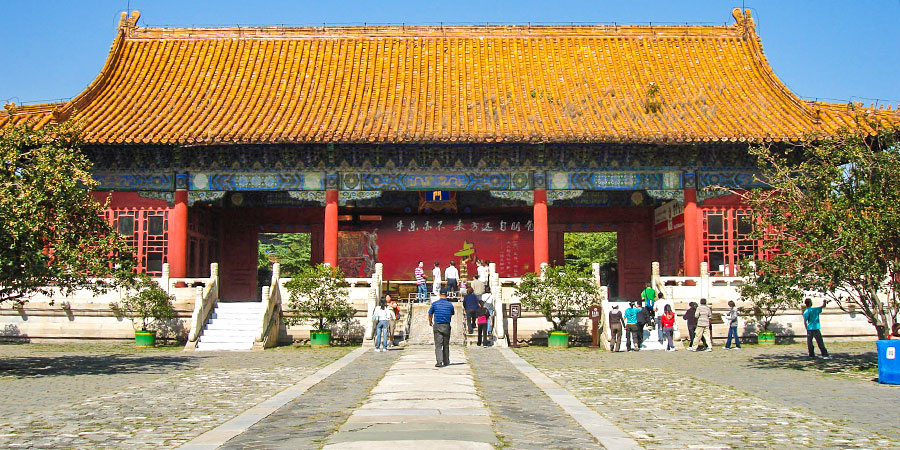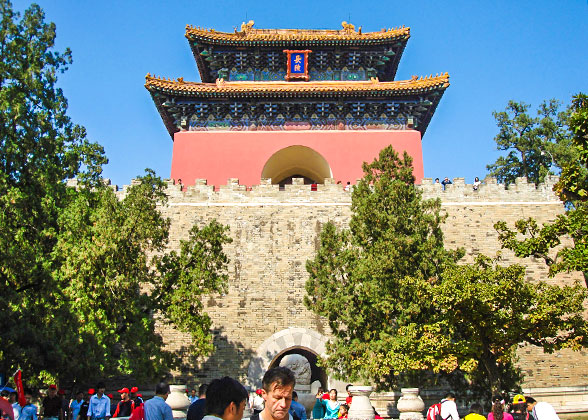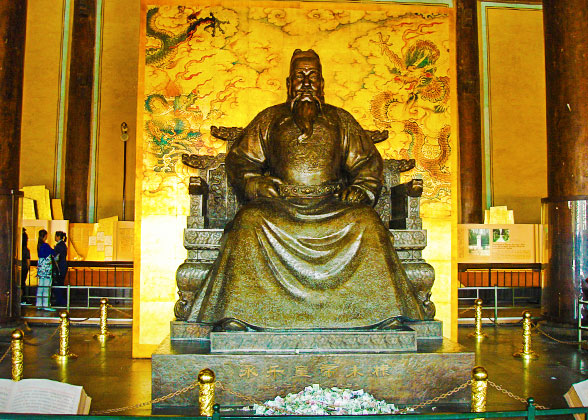Changling Tomb
Fifty kilometers (31 miles) away from Beijing lies Changling Tomb, the tomb of the third emperor of the Ming Dynasty (1368-1644), Zhu Di and Empress Xu. Among the 16 emperors of the Ming Dynasty, Emperor Zhu Di (1360-1424), also honored as Emperor Yongle, made the greatest contribution to the country and had the most far-reaching impact on history. During his time, the Ming Dynasty reached its peak.
In 1409, Emperor Zhu Di built Changling Tomb. He was the first emperor of the Ming Dynasty to build a tomb. After that another 12 tombs were built. Changling Tomb is the largest and the most completely preserved of these tombs. Because of its grand ancient architecture, brilliant culture and long history, the site is one of the most significant attractions in Beijing.This Changling Tomb scenic spot covers about 120,000 square meters (30 acres). Its layout is square in the front and round in the back. The square portion is divided into three connecting courtyards.
Approaching the Changling Tomb, you will first see the tomb's gate. It is an Alhambresque gate, the rafters and arch of which are all made of colored glaze. There are three small red doors under the gate. In the courtyard stands a perfectly preserved stele pavilion.
Passing through the first courtyard, you enter the second courtyard in Changling Tomb. It is the most attractive area of the tomb, worthy of careful appreciation. The gate to the second courtyard is named Blessing and Grace Gate (Ling’en Gate), which is 31 meters (102 feet) wide, 14 meters (46 feet) deep and 15 meters (50 feet) high. At the corners of the steps and under the railings are dragon-head-shaped stone drainages. The stone carvings on the stone road between steps are magnificent and majestic. The lower part of the carved picture is a surging sea, in which mountains stand and two sea horses are leaping out; in the upper part, two vigorous dragons are flying up and down, chasing fire beads.
Walking all the way up the steps, you will get to the main building of the Changling Tomb, the Blessing and Grace Palace (also known as Ling’en Palace), the place used for making sacrifices to Emperor Zhu Di and Empress Xu. This palace really deserves a visit for its uniqueness. It is the only preserved tomb palace from the Ming Dynasty and the only huge palace made of camphor wood. Perhaps it is also the most precious relic of the wooden architecture of ancient China. It covers about 2,000 square meters (0.5 acres). It is built on a three-story-high pedestal of white marble. The ceiling is colorfully painted and supported by sixteen solid camphor posts, among which the thickest one is 13 meters (43 feet) in height and 1.1 meters (3 feet) in bottom diameter. The floor is covered with golden bricks. Its hall is 67 meters (220 feet) in width and 29 meters (95 feet) in depth. The lifelike bronze statue of Emperor Zhu Di sits on the throne which is decorated with nine dragons.The most significant feature of the palace is that many objects and photos revealing the great achievements of Emperor Zhu Di are exhibited there. Some of these are very rare and precious, such as the portrait of Emperor Zhu Di, the portrait of Empress Xu, the Yongle Encyclopedia and a picture that depicts Emperor Zhu Di's main achievements including moving the capital to Beijing and constructing the Forbidden City, organizing scholars to compile the Yongle Encyclopedia and dispatching Zheng He to sail to the Atlantic. In addition, the palace displays hundreds of archaeological finds of the underground palace in the Ming Dynasty Tombs and shows a live video of the underground excavation, which help visitors to unlock the mystery of the underground palace.
In the third courtyard stand a few antique buildings, such as two stone archway doors called Lingxing Gate, at the top of which sit two dragons, a stone table and five offerings.
The back portion of Changling Tomb is Treasure City. Looked at from above, it seems like a closed circular castle. The 'city' is 7 meters (23 feet) in height. Inside the 'city' Emperor Zhu Di and Empress Xu were buried.
After visiting this place, you can visit the Sacred Way, Dingling Tomb and Zhaoling Tomb.
2. Take bus 872 from Deshengmen Bus Station to the destination.
3. Take bus 345 Express or 886 from Deshengmen West Station, get off at Changping Dongguan Station, and then take bus 314 to the tomb.
Beijing Bus / Subway Search
In 1409, Emperor Zhu Di built Changling Tomb. He was the first emperor of the Ming Dynasty to build a tomb. After that another 12 tombs were built. Changling Tomb is the largest and the most completely preserved of these tombs. Because of its grand ancient architecture, brilliant culture and long history, the site is one of the most significant attractions in Beijing.This Changling Tomb scenic spot covers about 120,000 square meters (30 acres). Its layout is square in the front and round in the back. The square portion is divided into three connecting courtyards.
Approaching the Changling Tomb, you will first see the tomb's gate. It is an Alhambresque gate, the rafters and arch of which are all made of colored glaze. There are three small red doors under the gate. In the courtyard stands a perfectly preserved stele pavilion.
 |
| Ling'en Palace of Changling Tomb |
Passing through the first courtyard, you enter the second courtyard in Changling Tomb. It is the most attractive area of the tomb, worthy of careful appreciation. The gate to the second courtyard is named Blessing and Grace Gate (Ling’en Gate), which is 31 meters (102 feet) wide, 14 meters (46 feet) deep and 15 meters (50 feet) high. At the corners of the steps and under the railings are dragon-head-shaped stone drainages. The stone carvings on the stone road between steps are magnificent and majestic. The lower part of the carved picture is a surging sea, in which mountains stand and two sea horses are leaping out; in the upper part, two vigorous dragons are flying up and down, chasing fire beads.
|
|
Walking all the way up the steps, you will get to the main building of the Changling Tomb, the Blessing and Grace Palace (also known as Ling’en Palace), the place used for making sacrifices to Emperor Zhu Di and Empress Xu. This palace really deserves a visit for its uniqueness. It is the only preserved tomb palace from the Ming Dynasty and the only huge palace made of camphor wood. Perhaps it is also the most precious relic of the wooden architecture of ancient China. It covers about 2,000 square meters (0.5 acres). It is built on a three-story-high pedestal of white marble. The ceiling is colorfully painted and supported by sixteen solid camphor posts, among which the thickest one is 13 meters (43 feet) in height and 1.1 meters (3 feet) in bottom diameter. The floor is covered with golden bricks. Its hall is 67 meters (220 feet) in width and 29 meters (95 feet) in depth. The lifelike bronze statue of Emperor Zhu Di sits on the throne which is decorated with nine dragons.The most significant feature of the palace is that many objects and photos revealing the great achievements of Emperor Zhu Di are exhibited there. Some of these are very rare and precious, such as the portrait of Emperor Zhu Di, the portrait of Empress Xu, the Yongle Encyclopedia and a picture that depicts Emperor Zhu Di's main achievements including moving the capital to Beijing and constructing the Forbidden City, organizing scholars to compile the Yongle Encyclopedia and dispatching Zheng He to sail to the Atlantic. In addition, the palace displays hundreds of archaeological finds of the underground palace in the Ming Dynasty Tombs and shows a live video of the underground excavation, which help visitors to unlock the mystery of the underground palace.
In the third courtyard stand a few antique buildings, such as two stone archway doors called Lingxing Gate, at the top of which sit two dragons, a stone table and five offerings.
The back portion of Changling Tomb is Treasure City. Looked at from above, it seems like a closed circular castle. The 'city' is 7 meters (23 feet) in height. Inside the 'city' Emperor Zhu Di and Empress Xu were buried.
After visiting this place, you can visit the Sacred Way, Dingling Tomb and Zhaoling Tomb.
How to get to Changling Tomb
1. Take subway Changping Line to Changping Dongguan Station, and then transfer to bus 314 to the tomb.
2. Take bus 872 from Deshengmen Bus Station to the destination.
3. Take bus 345 Express or 886 from Deshengmen West Station, get off at Changping Dongguan Station, and then take bus 314 to the tomb.
Beijing Bus / Subway Search
| Entrance Fee | April to October: CNY 45 November to March: CNY 30 Note: Free for children under 1.2 meters (3.9 feet) |
|---|---|
| Opening Hours | April to October: 8:00-17:00; November to March: 8:30-16:30. |
- Last updated on Aug. 16, 2024 by Gabby Li -

